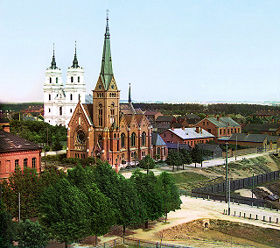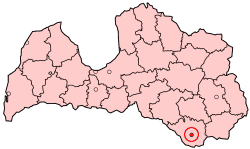Daugavpils
| Daugavpils | |
  |
|
 |
|
| A view of Daugavpils in 1912. | |
| Town rights | 1275 |
|---|---|
 |
|
| Location of Daugavpils within Latvia | |
| Location | |
| Mayor | Rita Strode |
| Number of city council members | 15 |
| Area | 72.48 km2 (28 sq mi) |
| Water | 9.75 km2 (4 sq mi) |
| Population | 108 260 |
| Density | 1,494 /km² (3,869 /sq mi) |
| Postal code | LV-540(1-2); LV-540(4-5); LV-5410; LV-54(12-15); LV-54(17-20); LV-5422; LV-5465 |
| Calling code | +371 654 |
| Time zone | EET (UTC+2) |
| Summer (DST) | EEST (UTC+3) |
| Homepage of Daugavpils | |
Daugavpils (IPA: [daugavpi:ls], pronunciation) is the second largest city in Latvia. It is located approximately 230 km south-east of the Latvian capital, Riga, on the banks of the Daugava River. Daugavpils has a favorable geographical position as it borders Belarus and Lithuania (distances of 33 and 25 km respectively). It is located some 120 km from the Latvian border with Russia. The city is surrounded by many lakes.
Contents |
Names
Daugavpils has been referred to by several historical names in various languages. Some are still in use today.
- Belarusian: Дзьвінск (Dźvinsk)
- German: Dünaburg
- Finnish: Väinänlinna
- Latgalian: Daugpiļs
- Lithuanian: Daugpilis
- Polish: Dyneburg, Dźwinów, Dźwińsk, with Dyneburg the only name still in use in Polish today
- Russian: Даугавпилс, Борисоглебск (Borisoglebsk 1656–1667), Двинcк (Dvinsk)
- Yiddish: דינעבורג (Dineburg)
Here is a chronology of name changes: Dinaburg (1275–1893 with some interruptions) >>> Borisoglebsk (1656–1667) >>> Dvinsk (1893–1920) >>> Daugavpils (1920–TODAY)
Demographics
As of 1 January 2006, the city had a population of 108 260.
- Russians: 53.96% (58 414)
- Latvians: 17.3% (18 725)
- Poles: 14.9% (16 126)
- Belarusians: 8.22% (8 897)
- Ukrainians: 2.23% (2 417)
- Lithuanians: 0.96% (1 041)
- Jews: 0.45% (492)
- Estonians: 0.03% (30)
- Others: 1.96% (2 118).
History
The town's history began in 1275 when the stone castle Dinaburg (Dünaburg) was built by the Livonian Order in the lands nominally controlled by the Grand Duchy of Lithuania. In 1561 it became part of the Polish-Lithuanian Commonwealth (see: Duchy of Livonia) and in 1620 became capital of the Inflanty Voivodeship, which existed until the First Partition of Poland.
From 1784 onwards, the city had a large and active Jewish population [1] with proeminent personalities.
As part of the Russian Empire it was called Borisoglebsk (1656-1667) and Dvinsk (1893-1920). The town was renamed Daugavpils in 1920 as part of independent Latvia. The city was the site of the Battle of Daugavpils from 1919 to 1920. Dvinsk was part of the Soviet Union 1940-41 and 1944-1991 and Nazi occupied from 1941-44. The town was the scene of fierce Jewish resistance during those years. During the Cold War it was the site of the Lotsaki air base, 12 km northeast of the town itself.
Art, architecture, and culture
Daugavpils is an important cultural center in eastern Latvia. There are 22 primary and secondary schools, four vocational schools, and the Saules College of Art. More than 1,000 teachers and engineers graduate from Daugavpils Pedagogical University and the local branch of Riga Technical University annually.
The city theatre was restored a couple of years ago. There is also one cinema as well as other cultural institutions. The city exhibition center offers many cultural activities.
There are also several architectural, historical, and cultural monuments in Daugavpils. The most prominent is the Daugavpils Fortress of the 18th century.
Airport
Daugavpils International Airport is located 12 km northeast of Daugavpils, near the village of Lociki. The airport is currently under development to allow both international and domestic passenger traffic, as well as international and domestic cargo transport and charter flights. It is expected to be operational by 2013.
Sports
- See also: Speedway Grand Prix of Latvia
The football clubs Dinaburg FC and FK Daugava Daugavpils play at Celtnieks Stadium in Daugavpils.
Le Parkour is also very poplar in Daugavpils. The famous parkour team, Dvinsk Clan started out on the streets of Daugavpils.
Notable residents
- Grzegorz Fitelberg (1879-1953), composer and conductor
- Isser Harel
- Gotthard Kettler (1571-1587), last Master of the Livonian Order and the first Duke of Courland and Semigallia
- Abraham Isaac Kook (1864–1935), rabbi, thinker, diplomat, mediator, scholar
- Solomon Mikhoels (1890-1948), actor and director
- the Rogatchover Gaon (1858-1936), rabbi
- Mark Rothko (1903-1970), abstract expressionist painter
- Władysław Raginis (1908-1939), officer
- Ulyana Semenova (born 1952), basketball player
- Meir Simcha of Dvinsk (1843-1926), rabbi
- Stanisław Swianiewicz (1899-1997), economist and historian
Twin Towns - Sister Cities
Daugavpils is twinned with:
References
- ↑ "Jewish families of Dvinsk". jewishgen.org. Retrieved on 2008-07-12.
- ↑ "Radom Official Website - Partner Cities".

 (in English and Polish) © 2007 Urząd Miasta Radom. Retrieved on 2008-10-23.
(in English and Polish) © 2007 Urząd Miasta Radom. Retrieved on 2008-10-23.
External links
- Information portal (Russian)
- Information-entertaining portal (Russian)
- Daugavpils on wikitravel
- Daugavpils history (Latvian) (Russian)
- Jewish community (Russian) (English)
- Vishki,a shtetl
- Vishki,a shtetl in Latvia (English) (Russian)
|
||||||||